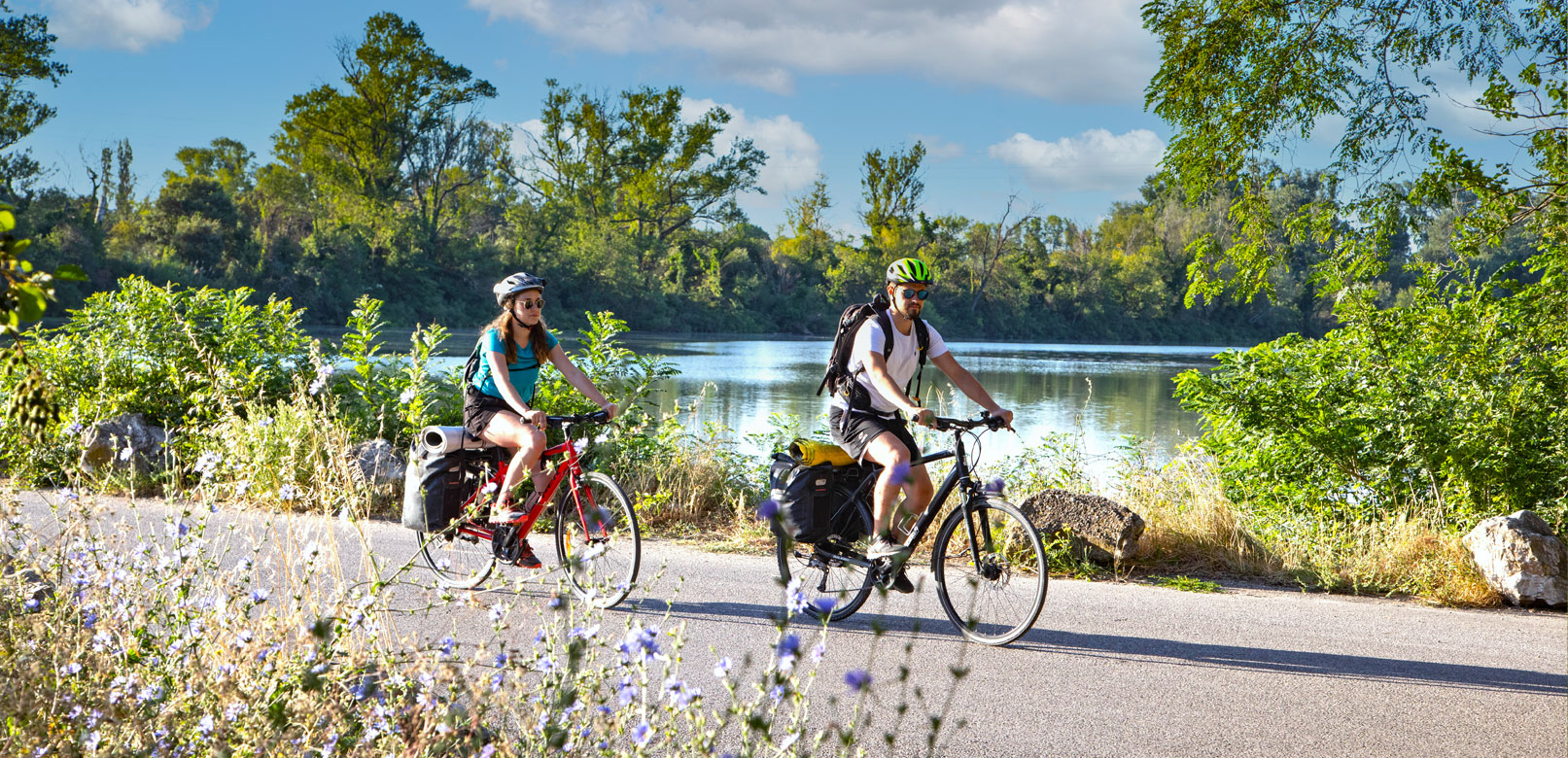
A slow holiday along the Via Rhona
From Montélimar to Avignon
I have travelled all over the world, from Gabon to the USA, Thailand, India and Korea… After visiting several cycling holiday forums and with a growing conscience about the environment, I decided to travel in a different way this year and try the experience with my man.
We set off from my house on a Friday at 9 a.m. for 3 days of cycling as a twosome on the Montélimar-Avignon stage of the Via Rhona cycling route.
facile
intermédiaire
difficile
Duration:
3 days
Distance:
97 km
Pratice:
Bike rides
Type:
round trip
Car park:
free
Day 1 : from Montélimar to Lapalud
We took the TER (Regional Express Train) with our bikes to Montélimar station, our saddlebags firmly strapped on. Three hours later, after enjoying a lunch full of the tastes of holidays, we picked up the trail again, travelling to Viviers then Bourg Saint-Andéol. What a wonderful surprise awaited us! Here we found swathes of fragrant lavender fields, serenaded by the song of the cicadas. Ah, the scent of Provence! At around 4 p.m., we arrived at the Provence Organic Farm in Lapalud, where we spent the night. Evelyne and Richard, our warm and friendly farmer hosts who were accustomed to the gentle wanderings of their guests, were experts on the Via Rhona. We set up our tent for free in their garden. And for €5, we had a pool! We enjoyed a well-deserved leisurely evening after this first excursion with our bikes. It was back to basics and the simple pleasures in life, as we savoured the tranquillity of the places we discovered after cycling 35 km. I finished the day reading a good book by the pool and in the hammock, among the chickens and the sheep.
That evening, we shared a friendly meal with three thirty-somethings from Nantes who were on their way to Spain on their bikes, and two retired German couples who were heading for the sea, along the Via Rhona. We shared stories of our adventures and exchanged tips for the cycling route. We had such fun joking about how uncomfortable the saddles were on our behinds! I rediscovered the joy of travelling at that moment. You never know what each day will bring, and chance encounters such as these create unforgettable memories. What matters is being together.
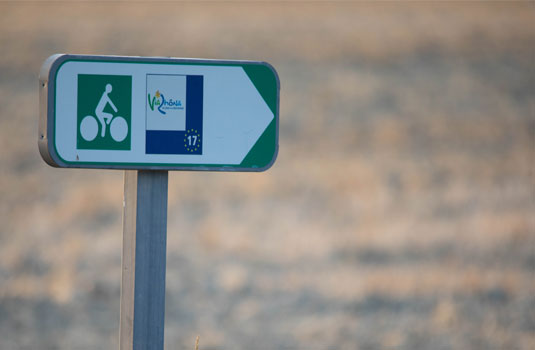

In brief
We definitely already had a sense of getting away from it all after this first day! The open air and the refrain of the pedals provided a clean break from our daily lives. We were both relaxed and exhausted!
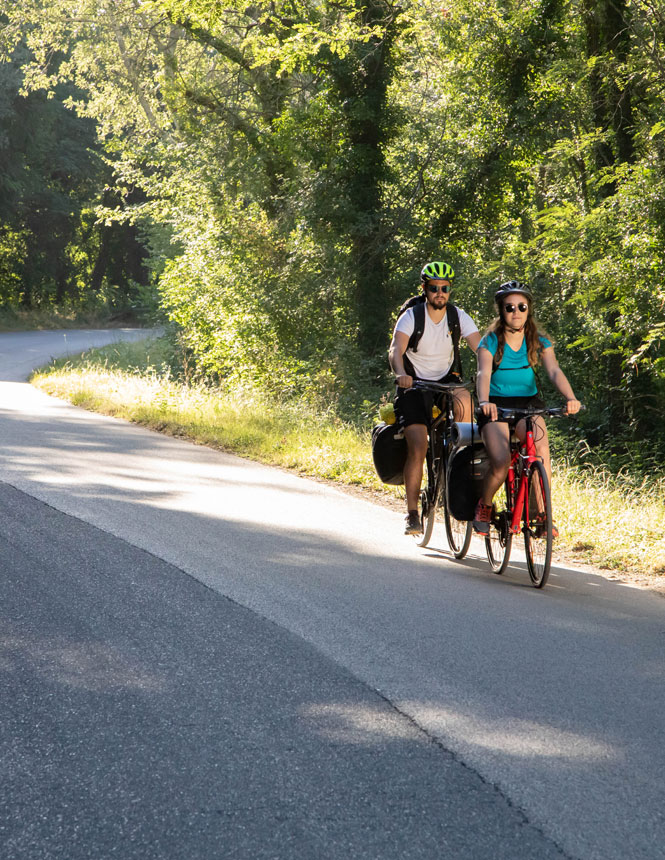
Day 2 morning: from Lapalud to Mornas – Mornas fortress and CNR power station
10 a.m.: We set off for a 36 km ride towards Orange, 7 km from Caderousse
After a generous breakfast, we resumed our route and cycled past the Donzère-Mondragon Canal and sunflower fields where farm workers waved to us.
In our sights was the majestic Mornas Fortress, perching atop a rocky outcrop at an altitude of 137 m. Is it impregnable, we wondered? We decided to go and explore it, and entrusted our saddle bags to the lockers at the Tourist Information Office. Perched atop a rugged cliff… Our tour unveiled the workings of the fortress over the centuries and its connection to the Rhône which, then at the foot of the cliff, was both a boundary and a busy transport hub to keep watch over. Parts of the fortress offered some truly breathtaking views over the whole Valley. It’s the perfect picnic spot! After the break, the cycle route along the banks of the Rhône was beckoning to us.

It’s worth the detour
10 km from Lapalud, you’ll find the CNR (National Company of the Rhône)’s hydroelectric power station, which is open to visitors (booking required). Here you can learn about the importance of the river to the valley, and the energy it produces.
A must: The Tourist Information Office in Mornas is equipped with lockers for your baggage and Bosch charging points for e-bikes.
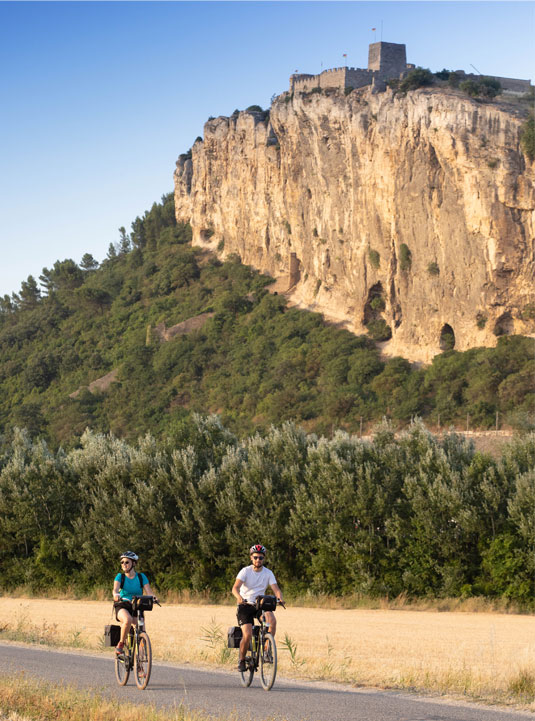
Day 2 afternoon: from Mornas to Orange – swimming and excursions
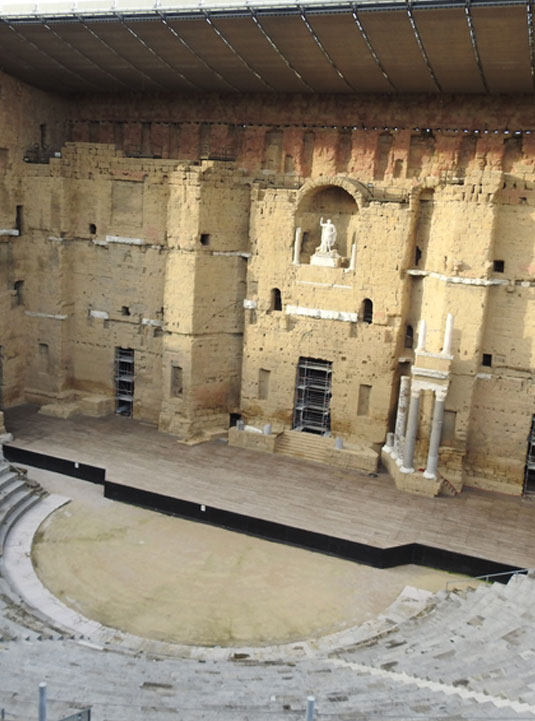

Good to know
The tourist trail reveals the history and architectural heritage of Caderousse, in particular its role in the 1944 liberation of Paris.
At the Wam water park
Solar panels tell us that we are approaching the water park. We leave the cycle route and a second lake appears, equipped by Wam Park (with inflatable structures and over-water ziplining). A break for a swim is a must; we’re changing into our swimsuits! Next we cycle along the Rhône to Caderousse, where a stop is highly recommended.
With its pretty belfry and imposing embankment to protect against flooding from the river, it’s a tranquil place that’s full of charm. Wandering through the narrow streets, I discover the Saint-Michel church and the square in front of it, with its bell tower and beautiful arches. It’s so quaint!
In Orange, we visit the Triumphal Arch and the Roman Theatre with its monumental wall, against which we feel tiny. On Saint-Eutrope hill, overlooking the city, the brick roofs and the theatre are tinged with orange when evening comes. The name of the city now makes total sense, and I discover the history of its connection to the Orange-Nassau Princes.
Day 3 morning: from Orange to Châteauneuf-du-Pape – A feast for the eyes!
10 a.m. Here we are leaving for the final stage, heading towards Avignon, our final destination! 36 km and it’s time for a gourmet stage
Many of the pavements have cycle paths, which makes leaving Orange pretty easy. After 10 km we pick up our route again, as the road climbs. It’s hard going with saddle bags! Travelling on a bike can be hard work. So I opt to make the climb at a snail’s pace. With regular breaks. The countryside blends into vineyards as far as the eye can see, and the road is dotted with “châteaux”. From the top of the hill, a panorama unfolds, and the winding road leads the way towards a sea of vines and cobbles, with the Rhône Valley and the river below. The view is stunning!
A beautiful descent signals our arrival at Châteauneuf-du-Pape. The labyrinth of narrow cobbled streets beckons you to take a stroll. We go up to see the ruins of the Château. Though the coast may be rugged, it is magnificent, with Mount Ventoux, the Dentelles mountains, the entire Côtes du Rhône vineyard and Valley, and Avignon which we can make out on the horizon. On our way back down, we stop off at Vinadéa, where you can taste various wines produced in the region. Of course we take advantage of this; these tannic red wines really are full of character! It was well worth stopping for. Returning to the temporary route below the village along a little wine route lined with poppies, we came across some busy vineyard workers on their tractors. It gave us a wonderful glimpse of authentic vineyard life! Looking back from a distance, the view over the village was equally beautiful.
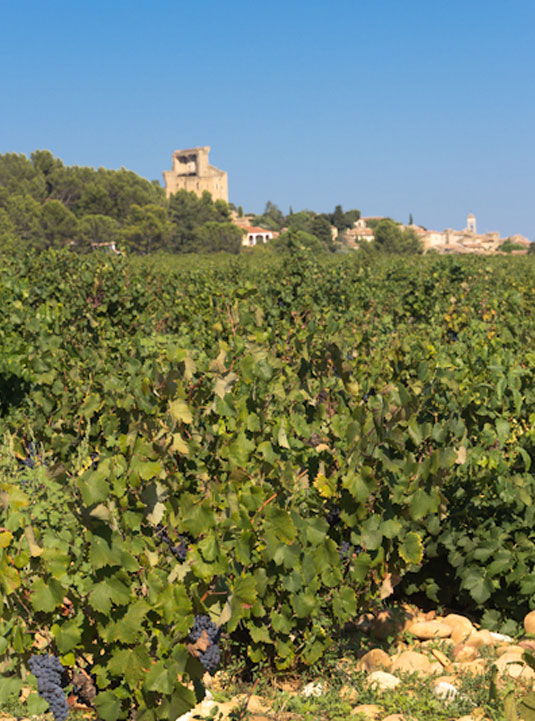
Day 3 afternoon: from Châteauneuf-du-Pape to Avignon
We leave the vineyards behind to find some shade and cool down along a branch of the Rhône. We cycle past the Passerelle des Arméniers footbridge, a magnificent suspension bridge. A picnic break on Ile de l’Oiselay is a must.
We pick up the route again, heading for Sorgues, still on the temporary route. After that, we are in a business park for 5 km. We need to go extra carefully. There are safety measures in place, but fortunately it’s only a temporary route. I wouldn’t advise this section of the route for families with children, who should take the train to Sorgues instead.
On our arrival in Le Pontet, GPS was essential. Once we had passed through the town centre, we found a cycle route along the canal and a very pretty woodland park. 7 km later and we arrived at Avignon’s city walls, which were surrounded by a lovely cycle route. We made it! We did it!
It’s so rewarding to reach your destination under pedal power, so happy to get there! I was very proud of myself.
For this last night, we had arranged accommodation on La Barthelasse, the largest river island in Europe. We cycled past the front of the Pope’s Palace, and there we were on the island. The reddening sunset on Avignon Bridge, the City, the bends of the Rhône river and Mount Ventoux will forever remain etched in my memory.
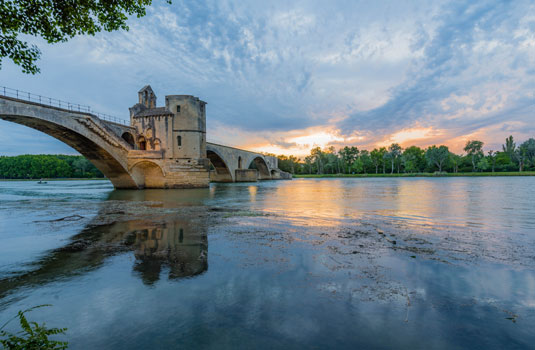

Where to eat
La Guinguette or the Vinotage Barge.
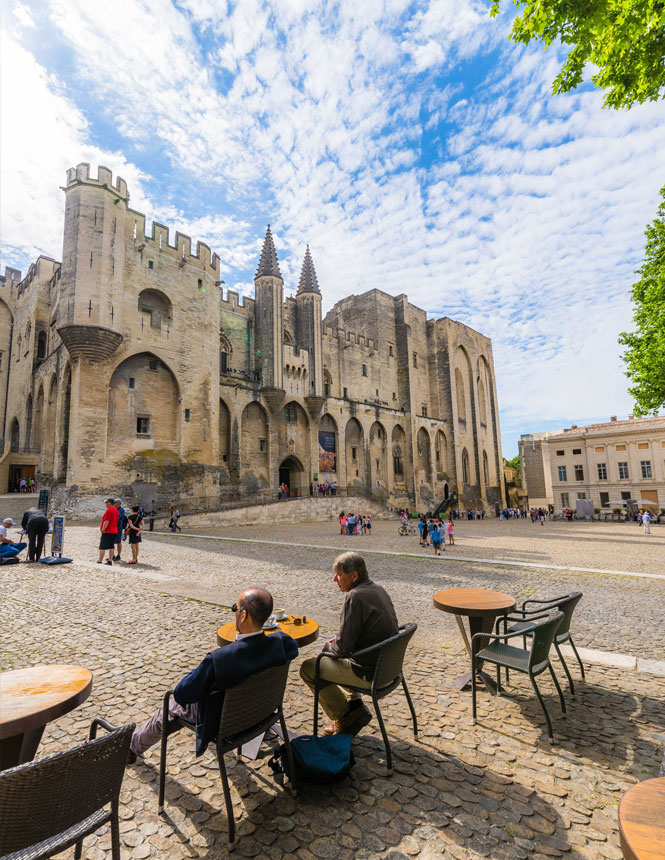
Our top tips
for your expedition along the Via Rhona
It’s better to cycle the Via Rhona from north to south! The Mistral will be your friend in this direction. Before you set off, check what direction the wind is blowing. In autumn and spring, when the mistral is too strong, the flat route can become hard-going and you will feel the cold more.